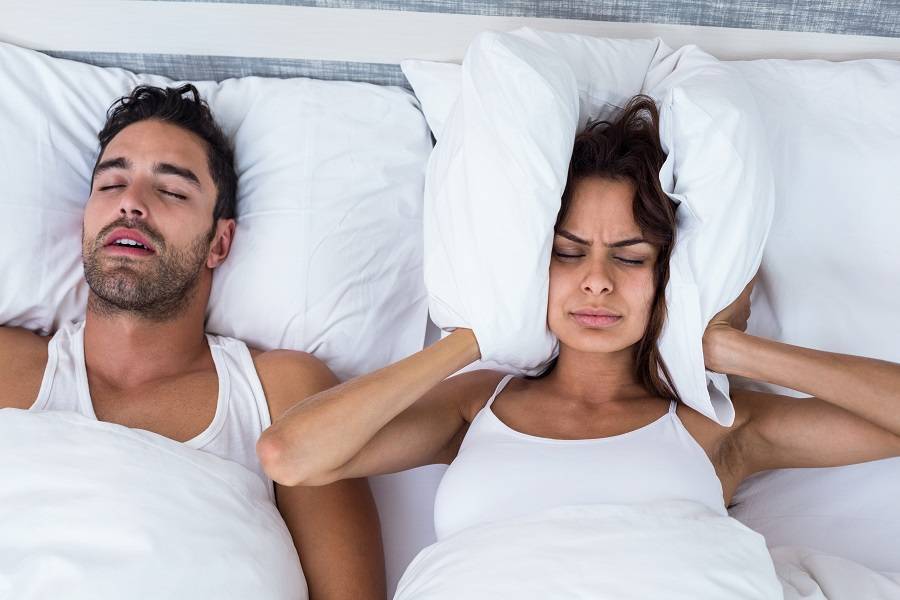Your partner just informed you that you have been snoring so loudly that they need to buy earplugs. At first you shake it off, thinking that your loud slumber is due to being exhausted after putting in extra hours at work. But then you remember reading that recent article about obstructive sleep apnea (OSA), and now you can’t shake the feeling that your loud snoring means that you have a sleep disorder.
Before you jump to conclusions, though, keep in mind that moderate to heavy snoring isn’t the same as sleep apnea.
Snoring is just a harsh vibration that happens when there’s resistance in your airway when you breathe. Obstructive sleep apnea means you have abnormal pauses in breathing (apneas) because of physical blockage in airflow.
Not all OSA sufferers snore. But those who do tend to snore loudly.
How to Tell If Your Snoring Is Sleep Apnea
At least 25 million Americans have been diagnosed with sleep apnea — with many more undiagnosed.
Most people aren’t aware they may have sleep apnea until a bed partner alerts them to the occurrence of raucous snoring or lapses in breathing.
Sleep experts use an acronym to help determine sleep apnea risk: STOP BANG. If you have more than 5 of these symptoms, you are at high risk for OSA and should discuss your symptoms with a trusted otolaryngologist such as Dr. Marc Kayem.
- S: Snoring
- T: Tired
- O: Observed
- P: Pressure
- B: BMI
- A: Age
- N: Neck
- G: Gender
S: Snoring
This is the kind of snoring that wakes up the neighbors, rattles windows and sets off car alarms. In a study of nearly 1,700 snorers, researchers found that the intensity of snoring was directly correlated to the severity of OSA found in the snorers.
T: Tired
Excessive daytime sleepiness is linked to sleep apnea due to less oxygen getting through at night, as well as restless or disrupted sleep. Other daytime symptoms include difficulty concentrating, morning headaches, and sore throat when you wake up.
O: Observed
Your partner has observed your apneas, telling you later that you have stopped breathing while sleeping. Sleep apnea can cause pauses in breathing of 10 seconds up to a minute or more. Eventually you rouse with a loud snort or gasping sound to force breathing. This pattern persists at least five times an hour for people with mild OSA, 16-30 times per hour for moderate OSA, and more than 30 times per hour for those with severe OSA.
P: Pressure
High blood pressure and sleep apnea are linked.
B: BMI
OSA has been on the rise along with obesity around the world since the 1970s.
A: Age
If you are over 50, you may be experiencing weakening muscle tone in your soft palate and neck, which could lead to obstructions in your airway.
N: Neck
The bigger the circumference of your neck (larger than 17 inches for men and larger than 16 inches for women), the higher risk you are for sleep apnea.
G: Gender
Men tend to carry more weight in their upper body (neck and stomach), which puts them at higher risk for OSA.
What to Do If You Suspect You Have Sleep Apnea
If you suspect you may have OSA, the first thing to do is contact your doctor to discuss your symptoms. Don’t delay — this is a quality-of-life issue.
Sleep apnea left untreated could lead to further health issues, including heart problems, Type 2 diabetes, abnormal cholesterol levels and liver problems.
Dr. Kayem uses a thorough evaluation to diagnose OSA:
- Physical exam: Some causes of sleep apnea are anatomical and easily discovered during a physical exam, a large tongue for example, or a nasal blockage.
- A history and evaluation of symptoms: We look for the warning signs of sleep apnea noted above, and evaluate them based on their severity.
- A partner’s observations: Bed partners are often the best source of information about nighttime breathing patterns.
- Sleep study: We partner with experts to conduct comfortable in-lab or in-home sleep studies.
During the sleep study, doctors use an apnea-hypopnea index (AHI) to diagnose OSA severity.
The AHI tells you the average number of times your breathing is interrupted per each hour of sleep. The higher the number, the more severe your sleep apnea.
While CPAP (Continuous Positive Airway Pressure) machines are an effective treatment for many, patients often experience difficulty using a CPAP machine.
Dr. Kayem offers these minimally invasive alternatives for those with mild or moderate sleep apnea:
- SnorEx®: This 10-minute office treatment, developed by Dr. Kayem, tightens the soft palate, reduces snoring, and helps to open your airway
- Radiofrequency (RF): These in-office treatments for the soft palate, tongue, and turbinate reduction stop airway obstruction by stiffening and/or reducing excess tissue via low power, temperature-controlled radiofrequency energy
If you have severe OSA, Dr. Kayem can recommend a surgical option that fits your particular situation.

